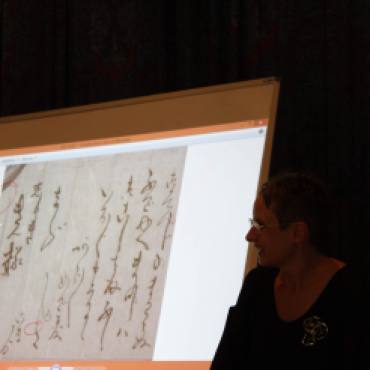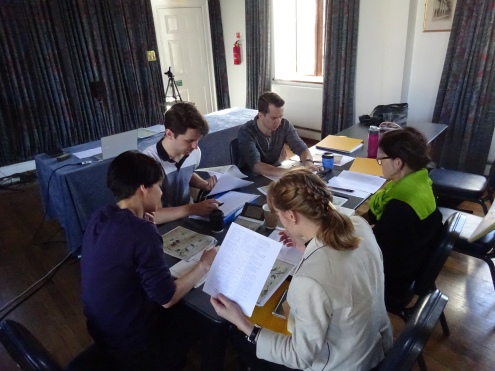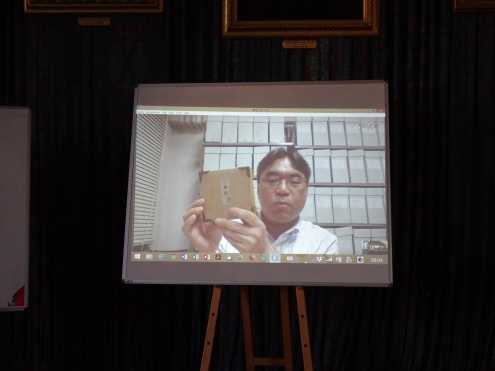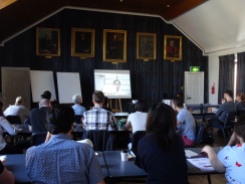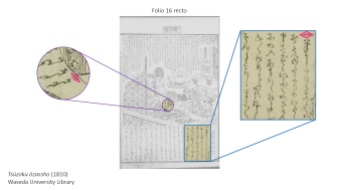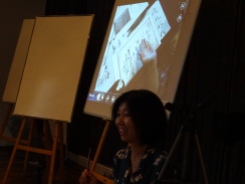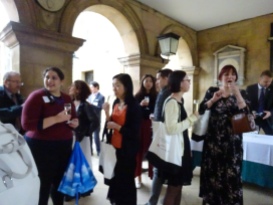Highlights summer school 2019
This year we welcomed 34 participants from all around the world.

The programme was, as always, intense. All the participants were kept engaged in group, pair, and individual work over a total of 72 hours of tuition. The first week explored primary sources that dealt with the idea of fushigi 不思議. We started with the didactic prose of Ejima Tamenobu…

…moved through manuals of magic tricks…

…and we ended up reading the story of Sato, a young girl who desperately wanted to turn into a man to fulfil her filial piety.

You can read from the Transcription how she managed to turn into a boy called Bunkichi.
On Saturday of the first week we printed from an early modern woodblock to read the publicity leaflet of a famous women’s medicine called jitsubosan 実母散, which is still produced today.
During the second week we read a number of komonjo and we also challenged ourselves with a letter written by a courtesan named Koma.



Calligraphy master Yukiko Ayres has reconstructed Koma’s hand in great detail, as part of a larger project on the genre known as nyohitsu 女筆 (lit. “the woman’s brush”).
For kanbun Prof Yamabe Susumu chose fascinating materials dealing with pleasure quarters.

For the second time, this year we have included a special project. The participants worked in pairs to transcribe and translate in its entirety the book entitled Fūryū tanuki no asobi 風流狸の遊 (Amusements of Fashionable Badgers), illustrated by Utagawa Yoshitoyo (1830-66). It is part of the private collection Ebi bunko, based in the UK and accessible in digital format on the Early Japanese Book Portal Database of ARC. For the time being we shared the transcriptions and the translations with the Ebi collector who wrote in great appreciation of this work:
Thank you for sharing with me the transcriptions and translations of_Fūryū tanuki no asobi produced by the participants in this year’s summer school. If possible, please convey my thanks to them for the hard work they put into elucidating this rare and curious booklet from my collection. It represents a side of Edo publishings (and literature!) that is generally neglected by scholars and collectors. Having it available allows us to gain a better sense of the breadth of popular publishing in early modern Japan. With best wishes,
The Ebi collector
Two lecture, one by Dr Ellis Tinios and the other by Prof Sasaki Takahiro, gave us a great deal of food for thought for fascinating research projects that open up once a scholar has access to primary sources in their original format.
See you next year!

Highlights summer school 2018
This year we welcomed 30 participants from all around the world. We all had a great time reading a variety of early-modern materials in wabun, sōrōbun, and kanbun.

All the participants joined after having done some preparatory work, for which Prof Yamabe Susumu and myself prepared ad hoc manuals and online resources. The programme of these two weeks was carefully put together to allow a progression from easier materials to more challening ones. For wabun we started with seventeenth-century materials that use mainly hiragana and moved onto materials that include a higher number of kanji without furigana. For sōrōbun we started with consolidating the basic grammar, then used letter templates, and then moved onto handwritten komonjo. In reading early-modern letters we also addressed the issue of constructing gender identity via letter-writing. For kanbun we first used texts that offer furigana, gradually moving onto materials with kunten only. The common thread of all these materials is the exploration of daily life in early-modern Japan: advice on sleeping, education of women, pleasure quarters, book reading, lending money, and much more!
Here we are working hard: in pairs, in groups and individually.
Many of the materials that we read come from the private collection Suzuran bunko (Cambridge, UK). So, we can enjoy early-modern books and monjo on a daily basis.
One of the remit of this Summer School is also to explore what topics are there to study in the field of Japanese palaeography. This year we had three wonderful lectures that made us aware of a variety of topics in textual scholarship and palaoegraphy.
Prof Sasaki Takahiro (Keio University) joined us via video-conference and talked about how scripts changed throughout the centuries and how they can help us dating materials. Here are some snapshots from his lecture 書物にみる仮名の変遷.
Dr Alessandro Bianchi (Haverford College) joined us via video-conference and opened our eyes on how early-modern woodblock printed books were carefully designed in every detail: Calligraphy, borders and mise en page. It was wonderful to see how paratext matters and how calligraphic choices allowed for a wide array of scripts.
Dr Ellis Tinios (Leeds University) made us aware of the interplay between manuscripts and printed texts in the Edo period: From Print to Manuscript. We were given the opportunity to reflect upon when, how and why woodblock printed texts were given a new life in manuscript form.
Every year we schedule sessions with calligraphy master Yukiko Ayres, which prove extremely successful in enhancing our reading skills. All the sessions are carefully designed with a view to understand on what ground certain calligraphic choices are made in the texts we are reading. It is eye-opening to understand how and why a calligrapher in the Edo period would have made choices of a kana variant over another and how they would have use the brush to create a running script. We ask a lot to master calligrapher Yukiko Ayres, because the Edo-period calligraphic styles have not really survived in the world of contemporary Japanese calligraphy. So, she is bringing to life scripts that have otherwise disappeared.
This year we also printed from an early-modern woodblock, that I bought from the lovely antiquarian bookseller Nagumo shoten 名雲書店 in Gunma.
It is an advertisement for the shop called Katayanagi-ten 片柳店 newly opened by Niemon 仁右衛門 in what is now the Tochigi Prefecture. We discovered he sold a variety of products that he gathered from various provinces in Japan, including sugar. We had great fun in printing from the block and then decode the publicity text written in sōrōbun.

But we also realized how hard it actually is to print in a way that allows to reach high-quality results. We understood how every tool (the hake 刷毛 and the baren 馬楝) matter. But also how important paper is!
And on the last day everyone had the opportunity to present their work on the special project.
But it was not only work. Every day allowed us to enjoy some great time together. On the Thursday of the first week we enjoyed a drink reception kindly offered by Emmanuel College. It was followed by a lovely dinner where we had the pleasure to welcome Minister Okada Takashi from the Japanese Embassy in London, the Director of the Japan Foundation London Ms Mana Takatori, Prof. Richard Bowring, and print-maker artist Nana Shiomi. We also had the chance to publicly thank Mitsubishi Corporation International (Europe) Plc, represented by Ms Julie Rogers, for their wonderful financial support, which made it possible for 9 of the 30 participants to come to our Summer School and for Prof Yamabe to reside in College.
Every coffee break gives an opportunity to network and to create friends for life.
– – – – – – – – – – – – –
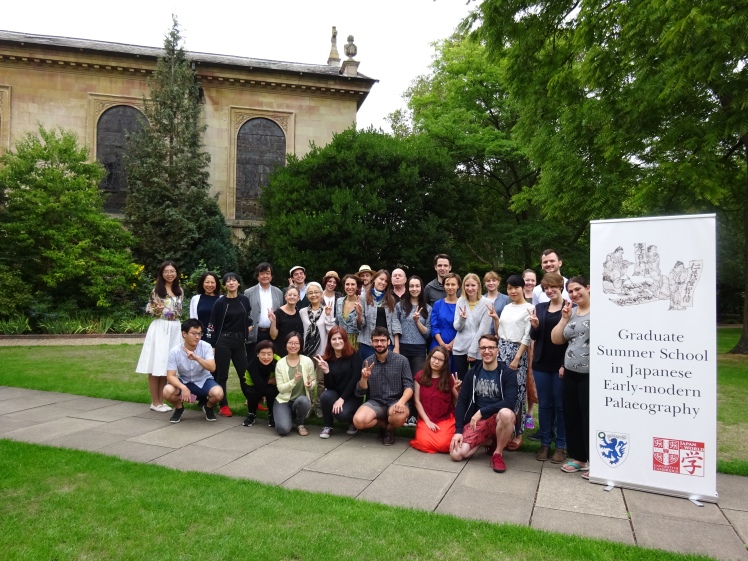
Thank you all for being so great!
Cambridge, 18 August 2018
Laura Moretti







